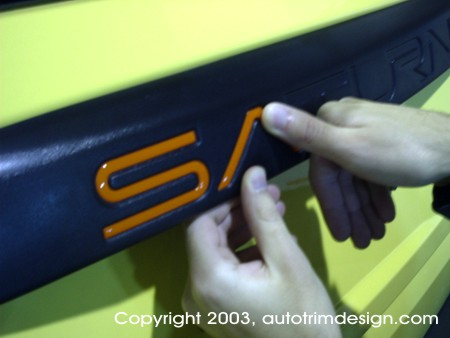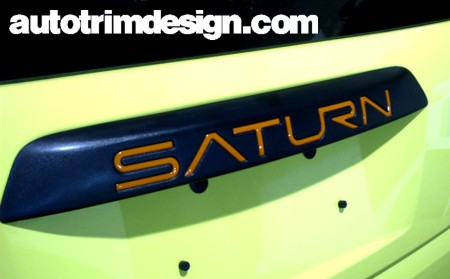 |
| Custom Domed Decal Installation Instructions |
 |
| Custom Domed Decal Installation Instructions |
| The following are the
application instructions recommended by Auto Trim DESIGN. These procedures must
be followed prior to any consideration by Auto Trim DESIGN and/or itís graphic
manufacturers in regard to replacement or credit.
Failure
to follow instructions listed below in bold red letters may result in product
failure and be considered non-warrantable. |
| Graphic Installation Instructions |
| Graphic Materials Information |
| Preparation & Cleaning Procedures |
| Installation Guidelines |
| Exterior Graphic Care |
| Graphic Materials Information | |
| Curing Time Information: | |
| For the most part, we manufacture decals as our customers order them. This ensures that they receive a "fresh" product, one that will last as per manufacturer's warranty. This being the case however, domed decals require a "Cure" time of no less than six (6) days. Thus, unlike our standard vinyl decals, shipping may be delayed by several days. It is our intent to manufacture your decals upon receipt of your order. Then, several days after the manufacture we will ship the product, thereby allowing for the recommended "Cure" time, which includes transit time. We endeavor to provide you with quality product and appreciate your patience. | |
| Storage and Rotation: | |
| Stock rotation and climate-controlled storage are important. Age and temperature extremes degrade the adhesive and can dramatically reduce its effectiveness. Product should be used within the recommended storage life of two years. In addition, product should be stored in an environment between 60 and 90 degrees Fahrenheit. | |
| Temperature Recommendations: | |
| Surface temperature should be between 50 and 90 degrees Fahrenheit before attempting the installation. As a general rule, if the surface is hot to the touch it's over 90 degrees Fahrenheit. Adhesive becomes brittle when it gets too cold and gummy when it gets too hot. Applications outside the recommended range of 50 to 90 degrees Fahrenheit reduce the adhesives' ability to perform. | |
| Preparation & Cleaning Procedures | |
|
****An Important Note about Cleaning. Please Read.**** |
|
|
Why Surface Preparation is More Important Than Ever Before! Due to an increased usage of silicone
based additives in automotive paint that traditionally contained only
solvents or oil derivatives, the pressure-sensitive graphics industry is
facing adhesion challenges. The result of these changes is the need for
increased awareness towards surface preparation and application methods. To reduce the amount of solvents in some
of the newer "heavy solids" paint and clearcoat products,
silicone-based additives are used as flow agents. As the solvents
evaporate during the curing process, silicone particles migrate to the
surface, leaving a silicone residue. In fiberglass manufacturing, mold
release agents may also leave a silicone residue. Traditional surface preparation for
graphics application has consisted of chemical washing. Most cleaners
contain a hydroxyl compound (acetone, alcohol) or a petroleum base
(kerosene, zylene) solvent. These solvents work by dissolving oil-based
impurities that are on the surface. Silicone, however, does not dissolve.
Removal of siliconates occurs through emulsification (suspension of
small globules within the liquid, like oil in water). Soap and water
will generally outperform solvent for silicone emulsification. However,
an extra wash process costs applicator time and it may not always be
necessary. |
|
| Cleaning
Procedures: |
|
All
surfaces are contaminated to some degree. To ensure good adhesion to any
vehicle surface, it is critical that you follow these recommended
procedures in decontaminating and preparing the surface prior to any
vinyl product installation. A clean,
lint free towel or cloth must be
used between each of the cleaning steps to prevent cross-contamination.
|
|
| Installation Guidelines | |
| Application Procedures: | |
|
|
|
Illustrated Installation Procedures |
|
 |
|
|
|
Step
1 Clean the surface with our Rapid Prep Pre-Cleaner or a few drops of grease-cutting liquid detergent in water (do not use a petroleum base cleaner). Rinse clean with fresh water then dry with a lint-free cloth. Wiping surface with our Rapid Tac, Rapid Tac II or alcohol will also help remove any contamination and enhance the adhesion process. |
|
|
Step 2 Remove the individual lettering from the Release Liner and carefully fit the lettering into the recessed area. Make sure that there is an even space all around the lettering. |
 |
Step 3 Once the lettering is placed into the recessed area, apply pressure with your thumb or non-marring tool. |
 |
Step
4 Step back and Admire! |
Exterior Graphic Care |
|
Today's finest pressure-sensitive vinyl materials have been used to create your new graphics. These graphics require little maintenance and should be treated similarly to a painted surface.
|
|
As always, if you have any questions feel free to e-mail us. We're here to serve. Thanks! |
| Need to contact us? Simply email us at technical@autotrimdesign.com. |
| Copyright © 2006 [Auto Trim DESIGN]. All rights reserved. |